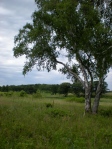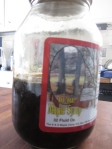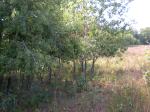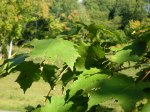It’s maple syrup making time in the Northeast. Jeanne explains the mechanics of sap flow, collecting sap for syrup making, and why maples are special in this regard.
I had the great pleasure last weekend to visit the University of Vermont’s Proctor Maple Research Center in Underhill, VT, where the sugar maple (Acer saccharum, Sapindaceae) sap is flowing. Sugar maple trees all around the northern hardwood forests in the Midwestern and Northeastern United States and southeastern Canada can now be “tapped,” fitted with a hollow tube in the sapwood, out of which sap flows and is collected and boiled down to maple syrup.
Maple syrup might be the oldest agricultural product in North America. Early 17th-century written records from Europeans exploring North America describe Native American use of sugar maple sap. We of course can’t know how Native Americans discovered sugar maple sap, but it may have been by sampling a “sapsicle,” icicles made from frozen maple sap that forms at the end of a broken twig. The evaporation of water during ice crystallization partially concentrates the sugar in the sap, making the sapsicle particularly sweet. To understand how that sap got to the end of the twig in the dead of winter and why it’s so sweet, we need some basics about plant vasculature and carbohydrate storage and must figure out what makes maples so special.
On a hot day in summer, a big sugar maple tree with its crown at the top of the forest canopy might move around 200 liters of water from the roots to the evaporating surfaces of leaves, 30 meters above the forest floor. Mineral nutrients from the soil, along with sugar and hormones and other physiological constituents manufactured or stored in the roots or stems sometimes also rise dissolved in the water and collectively form the sap. The sap ascends from root to leaf in the xylem.
Xylem consists of tracheary elements through which sap flows and the living and structural tissues (parenchyma and fibers) that surround and support them. Tracheary elements—made of vessels in angiosperms and tracheids in gymnosperms and more evolutionarily basal vascular plants—form a network of interwoven pipes, made of dead, hollow cells, joined end-to-end. Phloem is another set of pipes made of living cells that moves solutions within the plant with the aid of metabolized energy. The xylem and the phloem together comprise the vascular system in most land plants and evolved not long after plants colonized land.
Sap in the xylem moves passively, in response to physical forces, pressure and osmotic gradients. Three primary processes can cause xylem sap to flow: transpiration, root pressure and stem pressure. In order to turn carbon dioxide into sugar through photosynthesis, the leaf must open its stomata (small pores on the leaf surface) so that carbon dioxide can diffuse into the leaf. In doing so, however, the leaf must inevitably lose water by evaporation out of the stomata. This water loss is called transpiration and creates tension, or negative pressure, in the water in the xylem. Water moves up through the vessels to replace water lost through transpiration, in response to this pressure gradient. Transpiration during photosynthesis therefore pulls water up through the plant from the soil. When photosynthesis is done for the day, tension relaxes on the column of water in the xylem, and vessel pressure approximately equilibriates with that of soil water at the root surface.
Sap might also rise in the absence of photosynthesis because of root pressure. Sometimes a pressure gradient develops between the soil water and roots, usually because of high concentrations of minerals and organic compounds in the roots when photosynthesis is inactive. Water then flows into the roots and produces positive root pressure, pushing sap up through the xylem. Root pressure-generated sap flow in trees increases as the soil warms in the spring and ceases only when leaves develop enough to begin transpiring, thus eliminating day-time root pressure. Positive root pressure may still develop at night during the growing season and is partially responsible for dew production.

Pressure gauge attached to tap in sugar maple used in vacuum-assisted sap collection, Proctor research station, Underhill, VT.
Maple sap flow during the leafless season is physiologically unique in that it is largely independent of root pressure and only occurs on occasions between October and April when warm days follow freezing nights. Maple winter sap flow is caused by pressure in the stem generated by alternating daily cycles of night freezes and warm days. Cool evening temperatures generate negative pressure from the dissolution of gases in the xylem, which were seeded in from adjacent parenchyma and intercellular spaces. The negative pressure replicates the effect of transpiration, which draws still-liquid water from the soil into the roots. As the night freeze deepens, water freezes along the inner walls of the hollow fiber cells adjacent to the xylem and in intercellular spaces.

Cross section of xyelm in a sugar maple twig (2-years-old), 10x magnification. The large holes are vessels; the dark radial bands are rays
Eventually vaporized water on the surfaces of all cells freezes. The ice formation compresses and traps gases in the stem. The heat of the day melts the ice and causes expansion of the compressed gases, which generates positive pressure in the stem that pushes the sap up the stem and out the nearest exit, if one exists, such as a maple producer’s spile. Applying vacuum pressure to the tap allows a maple producer to collect up to three times the normal amount of sap, and doing so has been the industry standard since the late sixties.

Tubes run from the vacuum device to the tapped sugar maples and carry sap to the collection location, Proctor research station, Underhill, VT.
Because it depends on weather (and water availability) instead of spring leaf flush, maple winter sap flow is intermittent and highly variable from year to year. In any given season, a maple producer may have the opportunity to collect sap on one or ten or more daily “runs” of sap. The process occurs in all maples and sycamore (genera Acer and Platanus) and some other species, including butternut and walnut (Juglans spp., Juglandaceae) that spend the winter with water-filled vessels with air-filled fiber cells adjacent to the vessels. Most other species in the northern woods (including willow (Salix), aspen (Populus), elm (Ulmus), ash (Fraxinus), and oak (Quercus)) do not exude sap and spend the winter with gas-filled vessels and water-filled adjacent fibers. Some tree species (see below), most notably the birches (Betula), will exude sap from a spile in the later spring in response to positive root pressure.
The sugar in the sap stream is from carbohydrates stored in the living ray parenchyma and fiber cells adjacent to the vessels in the xylem and is mobilized in late winter and exuded into the xylem sapstream to fuel flowering and leaf expansion (maples flower before they leaf out). Most of the carbohydrates in the rays are actually stored as starch grains, and an enzyme released into the xylem throughout late winter converts the starch to sucrose and mobilizes it in the xylem. Sap sugar content also varies within a sap flow season, peaking in the middle. Therefore, there is quite an art to the timing of the tree tap. Producers should tap right before the peak sugar content sap flows. If they tap too early, the tap site might dry out, and they will collect mostly lower sugar content sap.
Maple syrup is mostly sucrose, but the maple xylem sap stream also contains glucose, inorganic salts, protein precursors (peptides and amino acids), some enzymes, and a few mystery organic compounds. The distinctive maple flavor is still something of a mystery but is variously attributable to the organic constituents of the sap and is amplified by heating. That is why maple syrup tastes differently from syrup from other trees, such as birch, or from syrup made from other plants, like sugarcane or sorghum (molasses is made from the combined xylem and phloem sap from both species).
Sugar maple is not the only tree species from which xylem sap is collected for consumption. Many species of birch trees (Betula spp., Fagaceae) are tapped for sap throughout the northern hemisphere. Sometimes the sap is boiled down for syrup, and there’s a growing birch syrup industry in Alaska, Russia and Scandinavia. Often, however, the birch sap is drunk or bottled as is, as a refreshing tonic. In North America sap is also sometimes collected from species in the Juglandaceae family (hickories and walnuts) and basswoods (Tilia spp: Tiliaceae). I suppose one might be able to extract sap from conifers during periods of root pressure sap flow, but this might be practically unfeasible because the collected sap might be inevitably contaminated with resin, the sticky pitch that visibly oozes from conifer wounds (which is not sap, even though it is sometimes called that). Throughout the tropics sap is collected from the crowns of palms for miel de palma (“palm honey”) and palm sugar. Maple species other than sugar maple also apparently make delicious maple syrup but have lower sap sugar contents, so one needs more sap to make syrup.
This list begs the question of whether any sufficiently large tree can be tapped for sap. The short answer is no. Whether a tree is worth the tap depends on geography and how much work you’re willing to invest and what flavor of syrup you’re willing to settle for. Sap can be collected from any tree in which sap flows from positive root pressure in the spring or from any maple (including sycamores) or walnut/butternut (Juglans) growing in a place with abundant soil water that experiences daily freeze-thaw cycles in late winter. The list of candidate trees is therefore winnowed down by first by location. The remaining questions to ask of your tree are: (1) will enough sap volume with (2) a high enough sugar content be collected to make it worthwhile to boil it down for syrup; and (3) what will the flavor of the syrup be when it’s done?
The volume question depends on the size of the tree, the diameter of the xylem storing water in the trunk (minimum 12” in diameter for a sugar maple, around a 40-year old tree), and more critically, on the water availability to the tree and the weather. For sugar maples, the larger the temperature difference between the night freeze and the daily thaw and greater the number of days in a season with big freeze-thaw cycles, the greater will be the volume of sap collected.
The sugar content question is economically critical. To make syrup, sap is boiled down until it is about 2/3 sugar. This means that if the sap has 2% sugar, as is typical for sugar maples, it takes 40-43 gallons of sap to make one gallon of syrup. Birch sap usually hovers around 1% sugar, so it takes over 80 gallons of sap to make one gallon of syrup. Some syrup producers run their sap through a reverse osmosis machine to remove some of the water from the sap to concentrate the solution before the boiling begins, so that less time and fuel will be necessary to reach the syrup stage. The higher the sugar content at the beginning of boiling, the lighter and more delicate will be the resulting syrup when it hits 66 or 67%, because the sugar will be less caramelized.
That is the difference between Grade A maple syrup and Grade B. More boiling, more heat, was necessary to produce Grade B because the sugar in the starting solution was more dilute. All the other stuff in sap, though, that contributes to the maple flavor, may or may not be more dilute in the sap destined for Grade B syrup, so Grade B might have a more intense maple flavor than the lighter Grade A. I actually always buy Grade B for this reason.
The sugar content depends on the species of tree and how much sugar it was able to store in its trunk over the winter. Shade tolerant species, such as syrup star sugar maple, tend to store more sugar in their trunks than do shade-intolerant species, such as aspen. If a sugar maple canopy sees enough sun and has enough water and nutrients in a summer to photosynthesize more sugar than it needs for its immediate, perhaps pre-programmed determinate, amount of growth and maintenance, it stores the extra sugar in the ray parenchyma cells in its sapwood, adjacent to the xylem. A shade-tolerant tree seems to always expect to have all or part of its future canopy shaded, either by itself or a neighbor, so it saves sugar to survive the lean times.
Shade-intolerant, species, however, have more of a “can’t take it with you when you go” philosophy, and quickly burn through much of their photosynthate by growing as much as they possibly can during the season. They’ll store enough sugar in their roots and stems to support respiration over the dormant season, provide frost hardiness (sugar is antifreeze), and to fuel budburst and leaf expansion or maybe even reproduction in the following year, and they might even hedge their bets by storing enough to fuel healing after injury or pest attack. The end result, though, is less stored sugar, so less sweet sap. So, even if sap can be collected from relatively shade-intolerant trees, which is sometimes the case, as with paper birch (Betula papyrifera), the sap will have a low sugar concentration relative to sugar maple sap, so it will take much longer to boil it down to make any kind of a syrup out of it. The sap of even a shade tolerant tree, however, might be too dilute to merit syrup making if the stored sugar doesn’t make it into the xylem sap when the sap could be profitably collected before budbreak. Such apparently is the case with American beech (Fagus).
Budbreak, the opening of the flower or leaf buds on the aerial shoots in the spring, requires the addition to the xylem sap of additional hormones, amino acids, defense compounds, and other physiological constituents that are either stored or largely manufactured in the roots and sometimes stems. According to most palates, these budbreak precursors in sap negatively affect the flavor of syrup produced from all tree species. Consequently, even if sap is still flowing, sap collection abruptly ends at budbreak for anyone wishing to avoid “buddy” syrup. Also, if you’ve got your eye on roadside maples for tapping and are particular about your syrup flavor, beware de-icing salt. Some studies have demonstrated that road salt in winter not only hurts the trees, because salt is toxic to most plants, but also imparts a bitter, salty flavor to the syrup made from sap of roadside trees subjected to salt.
Sugar content of sugar maple sap is highly variable across trees, as a consequence of genetic variation among individuals, soil fertility and water availability of the growing site, and previous year’s photosynthetic success. Sugar maple sap sugar content varies from less than 1 to over 10% but usually averages around 2 or 3%. More water and soil fertility and sun exposure is better for sugar yield.
Interestingly, then, if you wanted to plant a plantation of sugar maples, you’d have to space your trees far more widely for optimal syrup making than for optimal harvest of the highly-prized sugar maple timber. Wider spacing allows the branches to sprawl out and take advantage of the most sun per leaf, which maximizes seasonal sugar storage, whereas close spacing creates competition for light and causes the trees to invest in tall, straight trunks in their race to the top of the canopy, at the expense of stored sugar.
Drought stress or pests or diseases, especially defoliating ones, can also decrease seasonal sugar storage. A bad summer for the trees will lead to a bad spring for the sap collector. As long as there is water in the soil, there may be enough sap volume to collect, but the sugar reserves in it will be low. Research is ongoing into the genetic variation underlying sap sugar content and involves an effort to identify particularly “sweet” trees and propagate their offspring. Particularly high-sugar-yielding trees might have more and larger xylem rays than low yielding trees.
The hole in the sugar maple trunk from the tap heals in about 6 weeks. While the tap is in place and after it is removed, diseases could enter the tree through the hole. While the amount of sap removed by the syrup producer, accounting for an average 10% of stored sugar, will not mortally harm the tree, it does reduce its vigor a little bit and may make the tree slightly more susceptible to diseases during the healing period. Therefore, the conscientious syrup producer should seal the tap wound with an appropriate compound.
Sugar maple trees like it cold, and repeated freezing temperatures are necessary for a good spring sap flow. The current range of sugar maples is centered in the northern part of the Midwestern and Northeastern United States, with fingers of the tree’s range extending south to high elevation (coldish) sites. The range of sugar maple in North America is projected to shrink and move north, almost entirely out of the United States, over the next century in response to global climate change. The last few warm winters in the Mid-Atlantic and Northeastern U.S. have not been kind to maple sugar producers. So, if you love your maple syrup—not to mention the northern hardwood forests where sugar maples live—be sure to educate yourself about climate change and climate policy.
References
Pallardy, S. G. 2008. Physiology of Woody Plants. Third Edition. Academic Press.
Mohan, J. E., R.M. Cox, and L. R. Iverson. 2009. Composition and carbon dynamics of forests in northeastern North America in a future, warmer world. Canadian Journal of Forest Research 39: 213-230.
Valladares, F., and U. Niinemets. 2008. Shade tolerance, a key plant feature of complex nature and consequences. Annual Reviews of Ecology, Evolution and Systematics 39: 237-57.

















Thank you for a very useful article! I tap sugar maples in west Quebec and find there’s very little detailed information and this is most helpful.
LikeLike
I’m so glad you found it useful. The website for the University of Vermont Proctor maple research station is a real treasure trove of solid info: http://www.uvm.edu/~pmrc/?Page=publications.html. Hope you’re having a good sugaring season!
LikeLike
Thank you for a great description of sap flow. This is something I’ve been curious about all my life and now I think I finally understand it, thanks to your lucid explanation.
LikeLike
You’re welcome, Dale. We really appreciate the feedback about what’s working on the site, so thank you for your comment.
LikeLike
A few comments. We are in the midst of maple season here in the Northeast Kingdom of VT. Red squirrels will lick the sap oozing from small wounds on maple twigs and bite off little sapcicles. Most maple producers here tap early to get the first runs. Spouts with built in check valves, developed at UVM, help to keep the tap holes open longer by keeping bacteria away from the hole. Trees don’t “heal” the tap holes, they “respond” to the wounds, as is evident from staining in the wood around them, but the hole remains though it is covered over by new wood and bark in time. Maple producers here don’t treat the wounds after pulling the taps. Many have moved to smaller diameter taps which are just as effective with vacuum and leave less of a wound.
LikeLike
Thank you for your great observations, Jack.
LikeLike
What would happen to the tree if at the lower to mid trunk level the outer bark was torn off or removed?
LikeLike
http://en.wikipedia.org/wiki/Girdling
LikeLike
Pingback: How giant pumpkins got so big: A Q&A with Jessica Savage | The Botanist in the Kitchen
Pingback: Sugar | The Botanist in the Kitchen
Reblogged this on hARTiculturalish.
LikeLike
Pingback: Who’s ready for breakfast? | Sapindaceae
A very comprehensive article. Thank you.
I have a question. I tapped a few trees as an experiment when the temperature was around 60F and the evenings only dropped to 40s. At first tapping, sap was flowing quite nicely. When I returned to empty the expected full buckets, they were mostly empty and the flow had stopped, probably shortly after I left. I understand now it was due to the temperature not freezing thawing cycle. But my question is this… the rest of the week, the temps are expected to freeze and thaw like what is needed. Will the flow start up again? Thanks again.
LikeLike
I suspect when you tapped the tree initially you released sap that had accumulated during freeze-thaw cycles prior to the warm spell. I suspect more sap will accumulate under the right temperature regime.
LikeLike
Thank you
LikeLike
Pingback: Spruce tips | The Botanist in the Kitchen
Pingback: Plant of the Week – Sugar Maple – French in the Forest
Pingback: Syrup in the City: Maple Sugaring Tips - Forks in the DIrt
Isn’t “vacuum pressure” an oxymoron? “Applying vacuum pressure to the tap allows a maple producer to collect up to three times the normal amount of sap…” Maybe “vacuum-suction” instead?
LikeLike
I think it’s fine, although I am not an engineer.
LikeLike
Wonderful explain. I am a teacher in Brazil and will use this text to teache about xylem in high school classes.
LikeLike
Pingback: Leaf Xylem – Nature Wallpaper Site
Pingback: 鬆餅好朋友!你知道甜滋滋楓糖漿怎麼來的嗎? - 极速3d彩票/极速3d彩票平台/注册/官网 | 极速3d彩票/极速3d彩票平台/注册/官网
Jeanne, what an article! We’re attempting to recreationally tap 3-4 trees and the forest behind our house, which is in the city, has a nice hill which one would think should be a great setting for a sugarbush. Buttt, it seems mostly Norway Maples (looking at the bark and buds) which must have blown in from the Norways planted on the boulevard’s of the streets I would think.
There seem to be many on either side of the fence regarding tapping Norways, may I Ask your opinion?
LikeLike
Pingback: The Botanist in the Root Cellar | The Botanist in the Kitchen
Very interesting article, thank you. I have a question: sap flows up the xylem during warm days and when it is cold at night, I thought the sap returned to the roots. If this is true, does it go back down through the xylem? Or through the phloem?
LikeLike
Maple sap moves in the xylem. The column of sap is maintained through the night. Before bud break it moves in response to gas pressure, which depends on temperature.
LikeLike
Pingback: Is Sap Flammable? - FlameVenge
Thank you for this amazing article! I never knew how tedious the process of sap collection could be and I am now intrigued by how our climate crisis will impact it.
LikeLike
I live on the Connecticut River on the border of Vt & Nh. My property is full of past prime sugar maples on their way out. My question is how old might these trees be. Soon I will have cut them down to remove the possibility of them falling as a number of them have already done. Can I pick out young saplings to open up space for their success of growing to replace the old timers who are on their way out.
LikeLike
Your stand of old sugar maples sounds amazing, Joe, and it’s commendable that you want to encourage the next generation. I am not a maple forestry expert. Your local extension agency would likely have great advice for your specific situation. I would encourage you, however, to observe the understory in your maple stand, to notice where the young sugar maples are largest, healthiest, most robust.
LikeLike
Pingback: I was Inspired by the Trees | mittonmusings
Pingback: Maple Sap Science • The Community Classroom